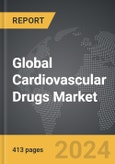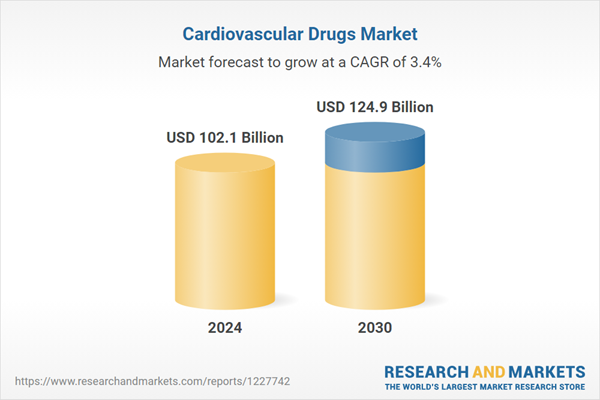The global market for Cardiovascular Drugs was valued at US$102.1 Billion in 2024 and is projected to reach US$124.9 Billion by 2030, growing at a CAGR of 3.4% from 2024 to 2030. This comprehensive report provides an in-depth analysis of market trends, drivers, and forecasts, helping you make informed business decisions. The report includes the most recent global tariff developments and how they impact the Cardiovascular Drugs market.
Segments: Drug Type (Anticoagulants, Antihypertensive, Antihyperlipidemic, Antiplatelet Drugs, Other Drug Types); Indication (Hypertension, Hyperlipidemia, Coronary Artery Disease, Other Indications).
Geographic Regions/Countries: World; United States; Canada; Japan; China; Europe (France; Germany; Italy; United Kingdom; Spain; Russia; and Rest of Europe); Asia-Pacific (Australia; India; South Korea; and Rest of Asia-Pacific); Latin America (Argentina; Brazil; Mexico; and Rest of Latin America); Middle East (Iran; Israel; Saudi Arabia; United Arab Emirates; and Rest of Middle East); and Africa.
The analysts continuously track trade developments worldwide, drawing insights from leading global economists and over 200 industry and policy institutions, including think tanks, trade organizations, and national economic advisory bodies. This intelligence is integrated into forecasting models to provide timely, data-driven analysis of emerging risks and opportunities.
Global Cardiovascular Drugs Market - Key Trends and Drivers Summarized
What Are the Different Classes of Cardiovascular Drugs?
Cardiovascular drugs encompass a broad range of medications designed to treat various heart and circulatory system conditions. These drugs are classified into several categories based on their therapeutic use and mechanism of action. Antihypertensives, including ACE inhibitors, beta-blockers, and calcium channel blockers, are used to manage high blood pressure, reducing the risk of stroke and heart attack. Statins and other lipid-lowering agents help control cholesterol levels, thus preventing the buildup of plaque in arteries. Anticoagulants and antiplatelets, such as warfarin and aspirin, are vital in preventing blood clots, thereby reducing the risk of conditions like deep vein thrombosis and pulmonary embolism. Additionally, diuretics are commonly prescribed to help reduce fluid retention and alleviate the symptoms of heart failure. Each class of cardiovascular drugs plays a specific role in managing and mitigating the risks associated with cardiovascular diseases, making them essential in modern medical practice.How Are Cardiovascular Drugs Developed and Approved?
The development and approval process for cardiovascular drugs is rigorous and highly regulated to ensure safety and efficacy. It begins with extensive research and development, where potential drug candidates are identified and subjected to preclinical testing. These initial tests involve laboratory and animal studies to evaluate the drug’s safety profile and biological activity. Successful candidates then enter clinical trials, which are conducted in three phases. Phase I trials assess the drug’s safety in a small group of healthy volunteers. Phase II trials focus on the drug’s efficacy and side effects in a larger patient population with the targeted condition. Phase III trials involve even larger groups to confirm the drug’s effectiveness, monitor side effects, and compare it with existing treatments. Upon successful completion of these trials, a comprehensive review by regulatory agencies like the FDA or EMA is required before the drug can be approved for market. This meticulous process ensures that only safe and effective cardiovascular drugs reach patients.What Are the Recent Innovations in Cardiovascular Drugs?
The field of cardiovascular drugs has seen significant innovations in recent years, driven by advances in medical research and technology. One notable trend is the development of personalized medicine approaches, where treatments are tailored to the individual’s genetic makeup and specific condition. This has been particularly impactful in the management of cholesterol levels, with the advent of PCSK9 inhibitors offering powerful new options for patients who do not respond to traditional statins. Additionally, the emergence of novel anticoagulants, such as direct oral anticoagulants (DOACs), has provided more effective and safer alternatives to warfarin, reducing the risk of bleeding complications. Innovations in drug delivery systems, including extended-release formulations and transdermal patches, have improved patient compliance and outcomes. Moreover, ongoing research into regenerative medicine and gene therapy holds promise for future treatments that could repair or even reverse damage caused by cardiovascular diseases, potentially transforming the landscape of heart health management.What Factors Are Driving the Growth in the Cardiovascular Drugs Market?
The growth in the cardiovascular drugs market is driven by several factors. Firstly, the increasing prevalence of cardiovascular diseases, fueled by aging populations and lifestyle-related risk factors such as obesity and sedentary habits, is creating a substantial demand for effective treatments. Advances in medical technology and a deeper understanding of cardiovascular disease mechanisms are leading to the development of more sophisticated and targeted therapies. The shift towards personalized medicine and the identification of new biomarkers for cardiovascular conditions are also expanding treatment options and improving patient outcomes. Additionally, the rising incidence of chronic conditions like diabetes, which are closely linked to heart disease, is contributing to the demand for cardiovascular drugs. Increased healthcare spending and access to medical services in emerging markets are further propelling market growth. Collaborations between pharmaceutical companies and academic institutions are accelerating the pace of research and development, bringing innovative drugs to market faster. These factors collectively drive the dynamic and expanding cardiovascular drugs market.Report Scope
The report analyzes the Cardiovascular Drugs market, presented in terms of units. The analysis covers the key segments and geographic regions outlined below.Segments: Drug Type (Anticoagulants, Antihypertensive, Antihyperlipidemic, Antiplatelet Drugs, Other Drug Types); Indication (Hypertension, Hyperlipidemia, Coronary Artery Disease, Other Indications).
Geographic Regions/Countries: World; United States; Canada; Japan; China; Europe (France; Germany; Italy; United Kingdom; Spain; Russia; and Rest of Europe); Asia-Pacific (Australia; India; South Korea; and Rest of Asia-Pacific); Latin America (Argentina; Brazil; Mexico; and Rest of Latin America); Middle East (Iran; Israel; Saudi Arabia; United Arab Emirates; and Rest of Middle East); and Africa.
Key Insights:
- Market Growth: Understand the significant growth trajectory of the Anticoagulants segment, which is expected to reach US$57.7 Billion by 2030 with a CAGR of a 3.9%. The Antihypertensive segment is also set to grow at 3.0% CAGR over the analysis period.
- Regional Analysis: Gain insights into the U.S. market, valued at $27.5 Billion in 2024, and China, forecasted to grow at an impressive 5.8% CAGR to reach $25.3 Billion by 2030. Discover growth trends in other key regions, including Japan, Canada, Germany, and the Asia-Pacific.
Why You Should Buy This Report:
- Detailed Market Analysis: Access a thorough analysis of the Global Cardiovascular Drugs Market, covering all major geographic regions and market segments.
- Competitive Insights: Get an overview of the competitive landscape, including the market presence of major players across different geographies.
- Future Trends and Drivers: Understand the key trends and drivers shaping the future of the Global Cardiovascular Drugs Market.
- Actionable Insights: Benefit from actionable insights that can help you identify new revenue opportunities and make strategic business decisions.
Key Questions Answered:
- How is the Global Cardiovascular Drugs Market expected to evolve by 2030?
- What are the main drivers and restraints affecting the market?
- Which market segments will grow the most over the forecast period?
- How will market shares for different regions and segments change by 2030?
- Who are the leading players in the market, and what are their prospects?
Report Features:
- Comprehensive Market Data: Independent analysis of annual sales and market forecasts in US$ Million from 2024 to 2030.
- In-Depth Regional Analysis: Detailed insights into key markets, including the U.S., China, Japan, Canada, Europe, Asia-Pacific, Latin America, Middle East, and Africa.
- Company Profiles: Coverage of players such as Abbott Laboratories, Inc., Astellas Pharma US, Inc., AstraZeneca PLC, Bayer AG, Boehringer Ingelheim GmbH and more.
- Complimentary Updates: Receive free report updates for one year to keep you informed of the latest market developments.
Some of the 113 companies featured in this Cardiovascular Drugs market report include:
- Abbott Laboratories, Inc.
- Astellas Pharma US, Inc.
- AstraZeneca PLC
- Bayer AG
- Boehringer Ingelheim GmbH
- Bristol-Myers Squibb Company
- Eli Lilly and Company
- F. Hoffmann-La Roche AG
- Gilead Sciences, Inc.
- Johnson & Johnson
- Merck & Co., Inc.
- Novartis International AG
- Otsuka Pharmaceutical Co., Ltd.
- Pfizer, Inc.
- Sanofi-aventis U.S. LLC
- Takeda Pharmaceutical Co., Ltd.
Tariff Impact Analysis: Key Insights for 2025
Global tariff negotiations across 180+ countries are reshaping supply chains, costs, and competitiveness. This report reflects the latest developments as of April 2025 and incorporates forward-looking insights into the market outlook.The analysts continuously track trade developments worldwide, drawing insights from leading global economists and over 200 industry and policy institutions, including think tanks, trade organizations, and national economic advisory bodies. This intelligence is integrated into forecasting models to provide timely, data-driven analysis of emerging risks and opportunities.
What’s Included in This Edition:
- Tariff-adjusted market forecasts by region and segment
- Analysis of cost and supply chain implications by sourcing and trade exposure
- Strategic insights into geographic shifts
Buyers receive a free July 2025 update with:
- Finalized tariff impacts and new trade agreement effects
- Updated projections reflecting global sourcing and cost shifts
- Expanded country-specific coverage across the industry
Table of Contents
I. METHODOLOGYII. EXECUTIVE SUMMARY2. FOCUS ON SELECT PLAYERSIII. MARKET ANALYSISCANADAITALYSPAINRUSSIAREST OF EUROPESOUTH KOREAREST OF ASIA-PACIFICARGENTINABRAZILMEXICOREST OF LATIN AMERICAIRANISRAELSAUDI ARABIAUNITED ARAB EMIRATESREST OF MIDDLE EASTIV. COMPETITION
1. MARKET OVERVIEW
3. MARKET TRENDS & DRIVERS
4. GLOBAL MARKET PERSPECTIVE
UNITED STATES
JAPAN
CHINA
EUROPE
FRANCE
GERMANY
UNITED KINGDOM
ASIA-PACIFIC
AUSTRALIA
INDIA
LATIN AMERICA
MIDDLE EAST
AFRICA
Companies Mentioned (Partial List)
A selection of companies mentioned in this report includes, but is not limited to:
- Abbott Laboratories, Inc.
- Astellas Pharma US, Inc.
- AstraZeneca PLC
- Bayer AG
- Boehringer Ingelheim GmbH
- Bristol-Myers Squibb Company
- Eli Lilly and Company
- F. Hoffmann-La Roche AG
- Gilead Sciences, Inc.
- Johnson & Johnson
- Merck & Co., Inc.
- Novartis International AG
- Otsuka Pharmaceutical Co., Ltd.
- Pfizer, Inc.
- Sanofi-aventis U.S. LLC
- Takeda Pharmaceutical Co., Ltd.
Table Information
| Report Attribute | Details |
|---|---|
| No. of Pages | 413 |
| Published | April 2025 |
| Forecast Period | 2024 - 2030 |
| Estimated Market Value ( USD | $ 102.1 Billion |
| Forecasted Market Value ( USD | $ 124.9 Billion |
| Compound Annual Growth Rate | 3.4% |
| Regions Covered | Global |









